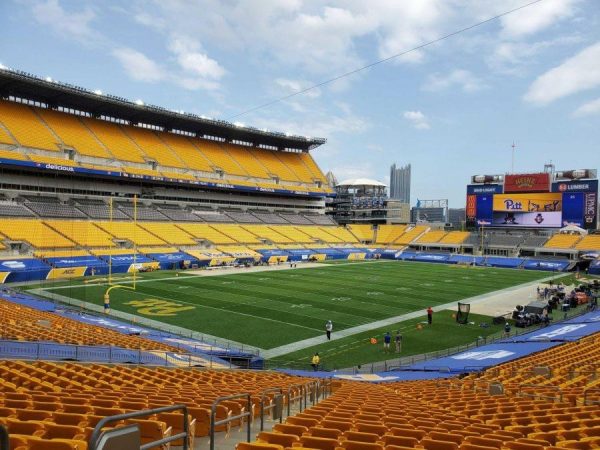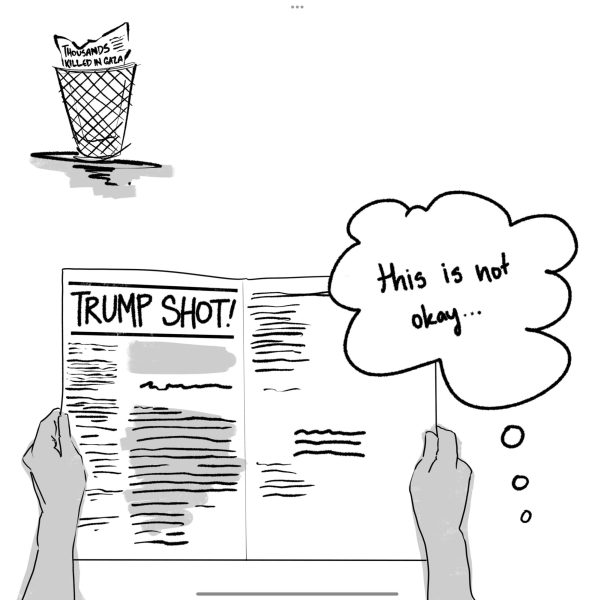Cecil Balmond blends line between engineering, art
December 2, 2009
Forum 64: H_edge
Cecil Balmond
Carnegie Museum of Art
412.622.3131
An engineering… Forum 64: H_edge
Cecil Balmond
Carnegie Museum of Art
412.622.3131
An engineering degree doesn’t prevent the inspired from dabbling in the arts.
Engineer Cecil Balmond has a metallic labyrinth currently featured at the Carnegie Museum of Art in Oakland.
The exhibit, “H_edge,” demonstrates how Balmond has used a visionary approach toward art and creatively applied mathematical formulas, ultimately challenging the definitions of architecture and engineering.
Balmond is an engineer of international recognition who has worked with many architects globally, as well as some artists, according to Raymund Ryan, architecture curator at Carnegie Museum of Art and curator for the exhibit.
“The key point on ‘H_edge’ is it’s an installation,” Ryan said. “It’s a labyrinth. The intention is people will enjoy wandering through this thing but be puzzled how it stays vertical.”
The structure seems so simple, yet it forms an elaborate and decorative maze. It’s composed of around 6,000 aluminum plates suspended between stainless-steel chains, which look like metallic ivy hanging from thin air.
The trick is that it’s standing from panels on the floor.
“The edges of leaves are inserted into the circles of the cables, and the whole thing becomes a taught system,” Ryan said. “It’s very light, but it creates a taut three-dimensional framework so that the thing can span like a portal or a doorway. But it looks very delicate. It’s strong and delicate at the same time.”
This delicate but sturdy creation is essentially an engineering and mathematical premise formed into a beautiful and intriguing object, he said.
“The end product, because it is so thought-out and more than applied science, becomes an art object in and of itself,” he said.
Born in Sri Lanka, Balmond is deputy chairman of Arup, the international design consultant firm based in London. Despite Balmond not being considered an artist by profession, Ryan believes “H_edge” is an admirable structure.
In addition to the actual metallic structure, there is a mirror on the wall that visually elongates the maze, as well as several information boxes, called light boxes, on the walls that contain designs and information about engineering principles.
For example, Balmond explains in short films embedded within the light boxes, the fractal “is a geometric idea that repeats at different scales.”
“In the light boxes especially … you can see that the notion of a coastline becomes fractal,” he said. “As you zoom in further and further, it essentially maintains the same form. I think you can find these things in lungs. If you take an X-ray you can find strange patterns in the lungs. It’s the same pattern existing in the same scale within itself. That’s one idea he is interested in.”
The boxes also explain connections between cultures and nature that deal with universally important numbers and other ideas and patterns.
Informative as this may be, there’s another goal of the exhibit.
“It should be somewhat mysterious,” Ryan said. “We try to get the lighting right. We want the natural light there, as well, when possible. The light should bounce around the complicated structure and create a sense of mystery.”
All of this information and mystery is tucked into a single room, going by the official name “Forum 64: H_edge,” because Balmond’s installation is No. 64 to go through the separated exhibition space.
The room sits between the Carnegie Museum of Natural History and the Carnegie Museum of Art. The little room usually holds contemporary works of art with just one or two pieces, creating a teaser for the visitors.
“‘H_edge’ appeals to the core historic mission of Carnegie Museums of Pittsburgh: the advancement of art and science,” Ryan said. “It plays to the issue of arts and sciences coexisting.”
On Saturday Nov. 21, a Pitt Arts-sponsored trip included a guided tour of the exhibit along with lunch at the Museum Café.
This exhibition takes place from Nov. 14, 2009 to May 30, 2010 in the Forum Gallery of the Carnegie Museum of Art in Pittsburgh. Balmond will also give a lecture Feb. 6, 2010.







